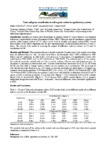Use este identificador para citar ou linkar para este item:
http://www.alice.cnptia.embrapa.br/alice/handle/doc/1023312| Título: | Trees and grass contribution to soil organic carbon in agroforestry systems. |
| Autoria: | TONUCCI, R. G.  GARCIA, R.   NAIR, V.   |
| Afiliação: | RAFAEL GONCALVES TONUCCI, CNPC; Rasmo Garcia, Federal Univ. of Viçosa (UFV) - Viçosa, MG, Brazil; Vimala Nair, Soil and Water Science Dep. Univ. of Florida, Gainesville. |
| Ano de publicação: | 2015 |
| Referência: | In: WORLD CONGRESS ON INTEGRATED CROP-LIVESTOCK-FOREST SYSTEMS; INTERNATIONAL SYMPOSIUM ON INTEGRATED CROP-LIVESTOCK SYSTEMS, 3., 2015, Brasília, DF. Towards sustainable intensification: proceedings. Brasília, DF: Embrapa, 2015. |
| Conteúdo: | Agroforestry systems have the potential to enhance carbon (C) sequestration in soil compared with treeless (agricultural) systems (Montagnini & Nair, 2004). When one type of vegetation is replaced with another, stable isotope contents (?13 C) values can be used to identify soil organic carbon (SOC) derived from residues in the native vegetation and the new vegetation based on discrimination between C3 and C4 plants. The present study aimed to assessing the impact of difference land-use systems on C3 and C4 contribution to SOC. The experimental area is located inside the Cerrado biome. Soil samples were taken from six different land-use sites: (i) native local forest; (ii) Eucalyptus forest (EF) established in 1985 (OEC); (iii) EF established in 2004 (NEC); (iv) pasture of B. decumbens; (v) Agroforestry System (AF) established on 1994 (OAF); and (vi) AF established on 2004 (NAF). The establishment on AF was placed first with the eucalyptus planted and rice (Oryza sativa), soybean (Glycine max) and braquiaria grass (B. Brizantha cv. Marandu) in between trees rows. Soil was collected from four depths (0-10; 10-20; 20-50 and 50-100 cm). For stable C isotope analysis, whole soil was analyzed mass spectrometer. The percentage of SOC derived from the Brachiaria ssp., a C4 plant, or from the eucalyptus or native forest, a C3 plant, was estimated based on the equations: % C4-derived SOC = (?- ?T)/(?G- ?T) x 100 (1); % C3-derived SOC = 100 - % C4-derived SOC (2) Based on the equations 1 and 2 were calculated the contributions of each C3 and C4 species in SOC C-derived, as follows: C3-devived SOC (Mg ha-1) = (% C3-derived SOC) x (SOC content, Mg ha-1) (3); C4-derived SOC (Mg ha-1) = (% C4-derived SOC) x (SOC content, Mg ha-1) (4). A complete randomized design was used with Tukey?s studentized. Statistical differences were considered significant at p <0.05. |
| Thesagro: | Solo Carbono Composto orgânico Uso da terra Cerrado |
| NAL Thesaurus: | Soil Organic compounds Land use Brazil |
| Palavras-chave: | Sistema agroflorestal Organic carbon Brasil Minas Gerais Agroforestry systems |
| Tipo do material: | Resumo em anais e proceedings |
| Acesso: | openAccess |
| Aparece nas coleções: | Resumo em anais de congresso (CNPC)  |
Arquivos associados a este item:
| Arquivo | Descrição | Tamanho | Formato | |
|---|---|---|---|---|
| cnpc2015Trees.pdf | 385,37 kB | Adobe PDF |  Visualizar/Abrir |









